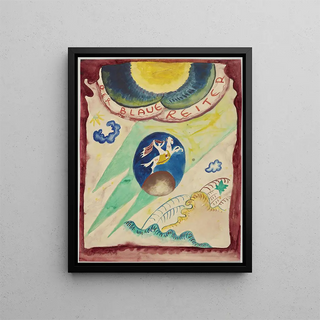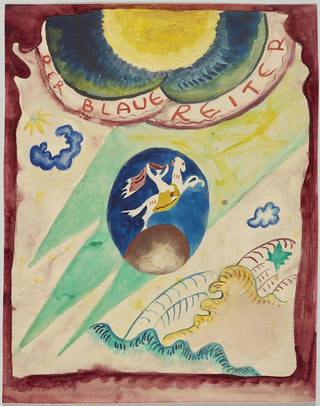Art print | Cover design of the Blue Rider III almanac - Wassily Kandinsky


View from behind

Frame (optional)
Conception of the cover for the art print The Blue Rider III - Wassily Kandinsky – Captivating introduction
The cover of the art print The Blue Rider III, designed by Wassily Kandinsky, stands as an iconic piece of the expressionist movement. Through this work, the artist invites us to immerse ourselves in a universe where shapes and colors break free from the constraints of reality. Created in 1912, it not only reflects the artistic innovation of its time but also embodies Kandinsky's quest to express emotions through art. By choosing a vibrant palette and abstract motifs, he manages to create an atmosphere that transcends mere visuals, engaging the viewer in a unique sensory experience.
Style and uniqueness of the work
The uniqueness of this piece lies in how Kandinsky merges abstraction and symbolism. Geometric shapes, often featured in his works, intertwine with organic elements, creating a dialogue between order and chaos. The colors, for their part, are not chosen at random; they are imbued with emotional and spiritual significance. Blue, for example, evokes depth and serenity, while red can symbolize passion or agitation. This bold use of shades and forms allows each viewer to interpret the cover in their own way, making the work deeply personal and universal at the same time. By incorporating elements of music and spirituality into his creative process, Kandinsky succeeds in transcending the limits of traditional painting to offer a truly immersive experience.
The artist and his influence
Wassily Kandinsky, an emblematic figure of modern art, played a crucial role in the evolution of abstract art in the 20th century. Born in Russia, he was influenced by various artistic currents, including Post-Impressionism and Fauvism, before developing his own distinctive style. As a co-founder of the group Der Blaue Reiter, he sought to promote a vision of art that favors personal expression and emotion over realistic representation. His influence extends well beyond his own era, inspiring generations of artists to explore abstraction and consider color

Matte finish

View from behind

Frame (optional)
Conception of the cover for the art print The Blue Rider III - Wassily Kandinsky – Captivating introduction
The cover of the art print The Blue Rider III, designed by Wassily Kandinsky, stands as an iconic piece of the expressionist movement. Through this work, the artist invites us to immerse ourselves in a universe where shapes and colors break free from the constraints of reality. Created in 1912, it not only reflects the artistic innovation of its time but also embodies Kandinsky's quest to express emotions through art. By choosing a vibrant palette and abstract motifs, he manages to create an atmosphere that transcends mere visuals, engaging the viewer in a unique sensory experience.
Style and uniqueness of the work
The uniqueness of this piece lies in how Kandinsky merges abstraction and symbolism. Geometric shapes, often featured in his works, intertwine with organic elements, creating a dialogue between order and chaos. The colors, for their part, are not chosen at random; they are imbued with emotional and spiritual significance. Blue, for example, evokes depth and serenity, while red can symbolize passion or agitation. This bold use of shades and forms allows each viewer to interpret the cover in their own way, making the work deeply personal and universal at the same time. By incorporating elements of music and spirituality into his creative process, Kandinsky succeeds in transcending the limits of traditional painting to offer a truly immersive experience.
The artist and his influence
Wassily Kandinsky, an emblematic figure of modern art, played a crucial role in the evolution of abstract art in the 20th century. Born in Russia, he was influenced by various artistic currents, including Post-Impressionism and Fauvism, before developing his own distinctive style. As a co-founder of the group Der Blaue Reiter, he sought to promote a vision of art that favors personal expression and emotion over realistic representation. His influence extends well beyond his own era, inspiring generations of artists to explore abstraction and consider color






